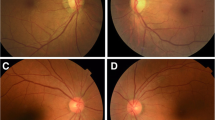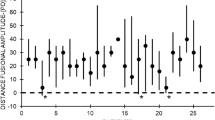Abstract
In our study we examined the influence of existing retinal correspondence on the result of squint operations for alternating convergent strabism. 157 patients under 10 years of age at the time of their first or only operation were included. They were divided into groups, depending on their age at the onset of squint and subgroups according to their type of retinal correspondence. The development of distance and near deviation was investigated separately. Covariance analysis demonstrated that the preoperative sensorial state is a predictor for the motor outcome of surgery with regard to postoperative distance deviation. Statistically we found at least noticeable results (p < 0.15) in all groups of patients - for acquired esotropia a significant result (p < 0.01). With regard to the postoperative near deviation we found a significant influence of the preoperative sensorial state only in the group of patients with a late onset of squint (p = 0.05). For patients with an earlier onset (before the 30th month) of strabismus, the preoperative angle of near deviation proved to have a significant impact on the postoperative development of near deviation (p < 0.05). Sensorio-motorial adaptational phenomena in esotropia are presumed to be the major cause for this difference.
Similar content being viewed by others
References
Flynn JT. Strabismus - a neurodevelopmental approach. New York: Springer-Verlag Inc., 1991: 59–117.
Taylor DM. Congenital strabismus - the common sense approach. Arch Ophthal 1967; 77: 478–484.
Campos, EC, Zanasi, MR Die anomalen Fusionsbewegungen: der senso-motorische Aspekt des anomalen Binokularsehens. Graefes Arch Clin Exp Ophthal 1978; 205: 101–111.
Maraini G, Pasino L. The treatment of early convergent squint - an analysis of the different factors influencing the final therapeutic result. Transactions of the First International Congress of Orthoptists 1967. London: Henry Kimpton, 1968: 107–114.
Lyle, TK, Wybar KC. Practical orthoptics in the treatment of squint. London: H. K. Lewis & Co., 1967.
Bagolini B. Objective evaluation of sensorial and sensorimotorical status in esotropia: their importance in surgical prognosis. Brit J Ophthal 1985; 69: 725–728.
Bagolini B. Anomales Binokularsehen und dessen Konsequenzen für die Schieloperation.In: Herzau V, ed., Pathopysiologie des Sehens, Bücherei des Augenarztes, Heft 98, Stuttgart: Ferdinand Enke Verlag, 1984: 233–236.
Burian HM. Fusional movements in permanent strabismus. Arch Opth 1941; 26: 626–652.
Halldén U. Fusional phenomena in anomalous correspondence. Acta ophthal (Kph.) 1952; Suppl. 37: 5–93.
Kretschmar S. La fausse correspondance retinienne. Doc Ophthalmol 1955; 9: 46–208.
Maraini G, Pasino L. Variations in the angle of anomaly and fusional movements in cases of small-angle convergent strabismus with harmonious anomalous retinal correspondence. Brit J Ophthal 1964; 48: 439–443.
Pasino L, Maraini G. Area of binocular vision in anomalous retinal correspondence. Brit J Ophthal 1966; 50: 646–650.
Bagolini B. Sensory and sensorio-motorical anomalies in strabismus. Brit J Ophthal 1974; 58: 313–318.
Bagolini B. Part I. Sensorial anomalies in strabismus (Suppression, anomalous correspondence, amblyopia). Doc Ophthalmol 1976; 41: 1–22.
Bagolini B. Part II. Sensorial anomalies in strabismus (anomalous movements). Doc Ophthalmol 1976; 41: 23–41.
Bagolini B, Zanasi MR, Bolzani R. Surgical correction of convergent strabismus: its relationship to prism compensation. Doc Ophthalmol 1986; 62: 309–324.
Prism Adaptation Study Research Group. Efficacy of prism adaptation in the surgical management of acquired esotropia. Arch Ophthal 1990; 108: 1248–1256.
Repka MX, Wentworth D. Predictors of prism response during prism adaptation. J Paed Ophthalmol Strabismus 1991; 28: 202–205.
Author information
Authors and Affiliations
Rights and permissions
About this article
Cite this article
Zehetmayer, M., Stangler-Zuschrott, E. & Schneider, B. Influence of existing retinal correspondence on the results of squint operations in alternating convergent strabism. Doc Ophthalmol 88, 127–139 (1994). https://doi.org/10.1007/BF01204610
Accepted:
Issue Date:
DOI: https://doi.org/10.1007/BF01204610




